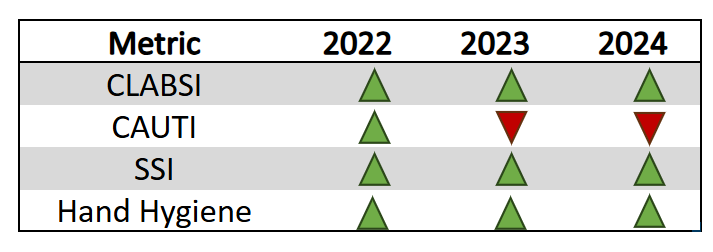At Nicklaus Children's Hospital, we dedicate ourselves daily to offering the best possible care to every child and family who come to us for hope and healing. We understand that quality and safety are the twin pillars of clinical excellence. We continuously evaluate our quality and safety performance to ensure that we meet and exceed national benchmarks and routinely incorporate evidence-based strategies to support a culture of continuous improvement.
Patients and families have an essential role in our quality and safety program. No one knows a patient better than the child's parents or guardians. We look to parents and extended family members to share insights to enhance care and create a better experience to meet each patient's needs.
Likelihood of Recommending Nicklaus Children's Hospital

In 2024, 84% of patients and families surveyed said they would be likely to recommend Nicklaus Children's Hospital.
Nicklaus Children's Commitment to Safety for All
At Nicklaus Children’s, safety is more than just a word; it is our promise—not just for our patients but also for families, staff, and the entire community. In 2024, we elevated this commitment by launching our "Safety for All" integrated safety and quality framework, designed to prevent harm to patients, staff, and visitors. Through this initiative, teams across the health system collaborate to continuously improve workflows and implement processes, focused on achieving numerous quality improvement milestones. This year, because of our focused efforts, we experienced a significant reduction in preventable safety incidents and a decrease in already rare healthcare-acquired infections.
“Our unwavering dedication to providing high-quality care has led to continuous improvements in patient and staff safety, operational efficiency, and better overall outcomes,” said Randy Harmatz Matott, SVP and Chief Quality Officer of Nicklaus Children’s Health System. “We will continue to build our legacy of safety and healing to better serve the children and families in our community and beyond.”
Measuring Care Quality
As we strive to provide the best care experience possible, we steadfastly track key outcomes and measures that serve as quality and safety indicators.
The measures shown below are only a small sampling of the data we routinely measure and report as part of our commitment to quality and safety. Through measurement over time, we can identify practices that enhance these outcomes and identify opportunities for improvement.

At Nicklaus Children's Hospital, patient safety and quality care are top priorities, and preventing Healthcare-Associated Infections (HAIs) is a key part of that commitment. HAIs are infections that patients can develop while receiving medical treatment or care in a healthcare setting. The best way to prevent the spread of infection is through proper hand hygiene, which is emphasized throughout the hospital. To minimize HAI risks, the hospital also follows strict infection control practices, including the safe use of medical devices and regular cleaning of facilities. Staff are continually trained to ensure they are up-to-date on the best infection prevention techniques. Nicklaus Children&'s also educates families and patients on how to reduce infection risks. By focusing on these efforts, the hospital creates a safe and healing environment for every child.
Collaboration to Improve Safety
Nicklaus Children's submits our CLABSI data monthly to the Children's Hospitals' Solutions for Patient Safety (SPS) national collaborative. Hospitals from throughout the U.S. are part of this network that tracks hospital-acquired conditions to share best practices regarding patient safety. The purpose of this is to help hospitals learn from their combined experiences so that all can enhance patient safety.
A Standardized Infection Ratio (SIR) is a measure used by the National Healthcare Safety Network (NHSN) to compare the actual number of infections observed in a healthcare setting to the expected number of infections based on national averages. The SIR is stratified for the population, meaning it accounts for differences in patient characteristics such as age, underlying health conditions, and other factors that may affect the risk of infection. This stratification ensures that the comparison is more accurate and reflects the specific patient population at each healthcare facility.
Standardized Infection Ratios help healthcare facilities understand how their infection rates compare to what would be expected given their specific patient population. An SIR above 1.0 indicates that more infections occurred than expected, while an SIR below 1.0 indicates fewer infections than expected. This ratio helps facilities identify areas for improvement in infection control.